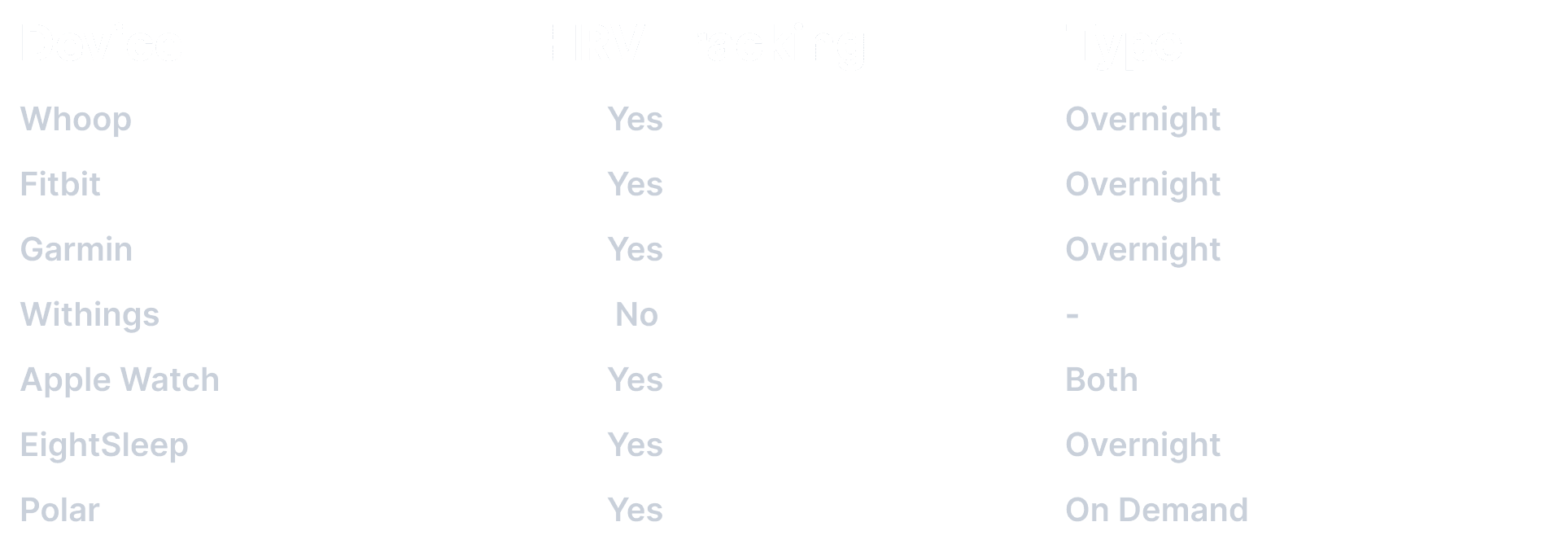<
Tracking your HRV
Aug 1, 2022

Dr. Darren Bowles
Tracking your HRV
The phenomenon of tracking your HRV is gaining serious traction, and not without reason.
HRV can be a useful proxy to see how well your body is managing your usual day-to-day stressors. This includes, but is not limited to: gauging recovery from exercise, monitoring the impact of mindfulness, and tracking how you’re rallying from a recent illness. HRV also makes waves in the field of longevity, with higher HRVs correlating with longer life span, and even in period tracking.
However, the realm of tracking your HRV can be tedious. Some of the main questions that crop up include:
1. Should I track my HRV?
2. How do I measure my HRV?
3. When should I measure my HRV?
4. What should I track my HRV with?
We tackle these questions below, but if you’re looking for more basic information on HRV, like what is HRV and what is a normal HRV, we have got you covered here.
Should I track my HRV ?
If you have an interest in knowing how well you’re coping with the goings-on of your life, then measuring your HRV could be invaluable to you. Whether it’s monitoring how a new training split, meditation plan, or diet change is affecting you, HRV is a powerful metric that allows you to implement changes to your routine and get objective feedback on your interventions.
However, when it comes to tracking your HRV, it is important to note that HRV is a supplement, not a substitute, to how you feel. Having a 'low' HRV does not mean you are incapable of exercise or handling additional stress. Having a 'normal' HRV after a heavy day does not mean you didn’t push yourself hard enough. Similarly, having a 'high' HRV does not mean that you should feel like you can take on the world.
Realising that a higher HRV does not always equate to good and a lower HRV does not always equate to bad is essential when it comes to interpreting your HRV trends.
How do I measure my HRV ?
Most wearables measure HRV. Some measure HRV over a set period of time, usually overnight, as Oura and Whoop do, and some measure HRV on demand - like Polar H10 and Apple Watch (with the Breathe app) do.
When HRV is measured overnight, it's measured automatically, which means no input is needed from you. On demand readings, however, require consistent, conscious effort in order to achieve the most accurate readings.
If the manner in which you record your HRV is not consistent, chances are your HRV readings will not be comparable, which is important when it comes to getting insights.
Fear not, as below we dive into some ways to ensure you get your readings as accurate as possible:
1. Take measurements as soon as possible after waking
Taking measurements, if possible, as soon as possible after waking helps to eliminate additional factors influencing your HRV. These factors can include changes in your hydration status, changes in your activity, and changes in your emotional state. All else being equal, there will be a noticeable difference between two HRV measurements if one is taken immediately after waking and the other is taken a few hours after you get up.
That being said - all is not lost if it doesn’t suit you to take your HRV immediately after waking. As long as you’re consistent in how you take your measurements every time you measure your HRV, you will get accurate, comparable readings.
2. Take HRV measurement for at least 1 minute
The leading ways in which HRV is measured (RMSSD & SDNN) are suitable to be measured over 30 heart beats, which the majority of people will reach within 1 minute. Longer measurements may be necessary if you suffer from frequent ectopic beats or an irregular heart beat.
3. Keep your posture/stance consistent
There is no right or wrong posture (e.g. sitting or standing) when it comes to measuring your HRV. However, changes in your posture can change your readings. When it comes to posture, as long as you remain consistent for each reading, your accuracy should not be affected.
4. Breathe normally
Consciously taking deep breaths, or controlling your breathing, can alter your HRV. In fact, it’s the premise for HRV biofeedback. Keeping you breathing at a normal rate will ensure that you’re not subconsciously altering your HRV, which could skew the results of your measurements.
Can I track my HRV throughout the day ?
Your HRV is sensitive to most fluctuations in your physiology. This means that measuring your HRV all the time throughout the day (as our technology currently stands) would be futile.
Unless you could measure every stressor in your life, and have a baseline to compare that stressor to - comparing HRV measurements at random periods throughout the day would be nonsensical.
Let’s put this into practice. You’re going to exercise at 2pm today, and, at 1pm, you look at your HRV to see how you’re set up for the workout. Shock Horror, your HRV is 36ms, which is well below your 30 day average. You may be put off exercising - thinking that you've had a stressful morning and your body needs rest rather than exercise, but what does this 36ms mean? In honesty, not much. Does this reading correlate with needing recovery, or does this change reflect the fact that you’re just perspiring more in warmer conditions, or that you ran up the stairs before taking the reading, or does your reading reflect a plethora of different factors that transiently influence your HRV. The fact is - your reading reflects all these things.
Unless all the other factors influencing your HRV have been considered, measuring your HRV throughout the day would be a frustrating endeavour. This is where overnight readings come in handy. During the night, the transient factors that impact your HRV will be limited, which gives a more comprehensive view of how your body is coping to stressors.
So measuring your HRV all day long, as technology stands now, would not be in your best interest, which the battery on your device may be thankful for.
What devices track HRV
Below is a list of the most popular companies in the wearable space and information on how they (or their flagship devices) track HRV.

Bottom Line
When it comes to HRV tracking, keeping your measurements consistent is key. Interpreting your HRV involves keeping your days contextualised, and, finally, HRV is one tool of many on your path to health.
References
Heart rate variability indices for very short-term (30 beat) analysis. https://link.springer.com/article/10.1007/s10877-013-9473-2
Effect of posture on heart rate variability in school children https://pubmed.ncbi.nlm.nih.gov/24579538/
Postural Changes on Heart Rate Variability among Older Population: A Preliminary Study https://www.ncbi.nlm.nih.gov/pmc/articles/PMC7937484/